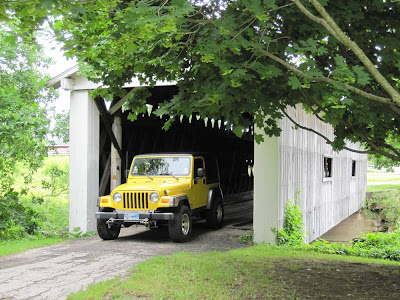Since reading the book, The Bridges of Madison County, CC has been captivated by this architectural anomaly; each one, uniquely different. Pennsylvania boasts the most of any state, and it is reported that the Amish from that area brought the concept with them as they migrated westward. While we were staying at Kennisee Lakes just outside of Jefferson, Ohio, we discovered that Ashtabula County has a total of 17 covered bridges, and so it was, a day of exploration was a must do. (As usual, click on any image to enlarge)
Each bridge has a “badge”,that describes the statistics of that bridge. What amazed me was the fact that there seems to be no “standards” for this type of construction. No minimum or maximum on widths, heights, clearances or lengths. It appears the bridge designer has complete artistic freedom to design in any way, shape, fashion or form he chooses.
Most of America's covered bridges were built between 1825 and 1875. By the 1870s, most bridges were covered at the time of construction. The original reason for the cover was to protect the bridge's trusses and decks from snow and rain, preventing decay and rot. The cover served other purposes also-it kept horses from being spooked by the waters underneath, it was a reprieve from weather to the weary traveler, and it was used for political rallies, religious meetings, a night's sleep for tramps, town meetings, poker parties, sweethearts' rendezvous, drunken revels, dances, and even rainy-day luncheons took place on the covered bridge. An uncovered bridge would last approximately 20 years but a covered one could last 100 years.
The Graham Road Bridge, which was built from remnants of a bridge washed downstream in the 1913 flood, now sits in a small park on the south side of the road. The 97-foot Town Truss was over the west branch of the Ashtabula River in Pierpont Township.
The people of Ashtabula County truly embrace their covered bridges, and are determined to keep the concept, and to some degree, the culture of such alive for future generations. New bridges are being built using the same design concepts and principals of the past.
We will now be making our way to the Winnebago Itasca Grand National Rally in Forest City, Iowa, that runs from July 17 – 22. I think we both just realized how far we must travel to get there, so will double up our travel plans and move at the speed of light, around 100 miles per day, which will drastically alter our sightseeing agenda. Oh well, it’s a tough lifestyle we lead, so please don’t try this if you are faint of heart.

















100 miles a day! Wow, that is really fast. Hope you arrive at the GNR with all the paint on your MH still attached... ;c)
ReplyDeleteNice pix of all the bridges, too.
Paul,
ReplyDeleteWhen we started this full time adventure, we were doing 300-400 miles per day. Then someone asked us, "What's your hurry? Do you have a doctors appointment?". So we got the hint, stop and smell the roses along the way. I suspect you were just poking fun at our travel plans, and that's OK. Can we expect to see you at the rally?